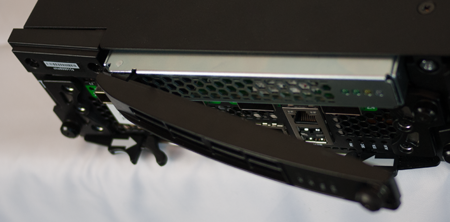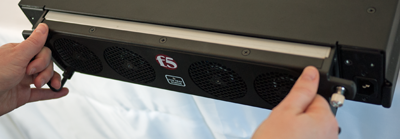Applies To:
Show Versions
Platform Maintenance
About maintaining the platform
The VIPRION® 2200 platform contains several components that you can replace individually without exchanging the entire system. This platform contains these replaceable components:
- AC power supply
- DC power supply
- Fan tray
- Storage drive assembly
Note: Applies only to the B2100 blade with hard disk drive (HDD).
- Blades
About AC power supplies
The VIPRION® 2200 platform supports one to two hot swappable AC power supplies. The power supplies are auto-ranging 100-240VAC input.
The platform supports power redundancy, which ensures that the system is unaffected if a single power supply fails in a system containing more than one power supply.

A power supply partially removed from the platform
Removing a power supply
Installing a power supply
About DC power supplies
The VIPRION® 2200 platform supports up to two hot swappable DC power supplies.
The platform supports power redundancy, which ensures that the system is unaffected if a single power supply fails in a system containing more than one power supply. The DC power supply includes a DC input connector.
The DC power supply does not have an on/off switch. You can control the power from the rack switch or the DC power source.
Removing a power supply
Installing a power supply
Wiring the DC connector
You will need these components to wire the DC power supply:
- Wire stripping tool
- Two 6 AWG copper wires long enough to reach from the platform to the DC power source

VIPRION 2200 DC power supply and connector
Connecting DC power to the platform
About the fan tray
The VIPRION® 2200 platform has a removable fan tray that is designed to maintain airflow throughout the chassis. You can change or replace the fan tray as part of the routine maintenance of the unit, or in the event of a fan failure. The fans in the fan tray run constantly while the unit is on. Over time, the fans can wear out, requiring you to replace the fan tray.

The VIPRION 2200 platform fan tray
Replacing the fan tray
About the storage drive assembly
By default, VIPRION® B2000 Series blades contain one storage drive assembly that contains either one hard disk drive (HDD) or one solid-state drive (SSD).














